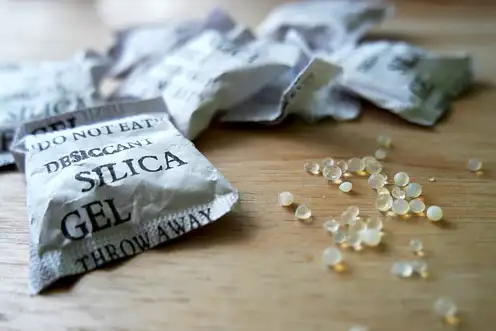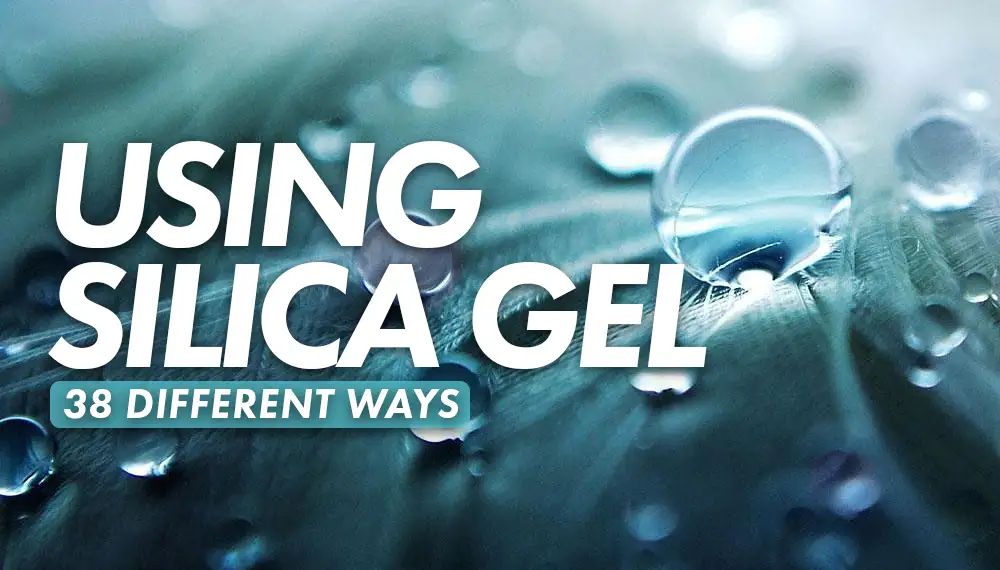Silica Gel is a versatile and useful substance that removes humidity from the air around it (it’s an adsorbant desiccant). I use Silica Gel every day, in multiple ways. It is non-toxic by itself, and can be modified to indicate when it is fully saturated with humidity (indicating silica gel). What’s more, you can heat Silica Gel to recharge it repeatedly, and reuse it a few hundred times. This makes it a very cheap, and eco-friendly means of humidity control. Silica gel has multiple uses in homes, offices, and in the field, making it a useful sticker to have at home, the workshop, or in an office.
In this article, we look at 38 different uses of Silica Gel around the house, in the workshop, and beyond.
Table of Contents
Different Ways to Use Silica Gel
Here, we list some traditional uses for silica gel, as well as some rather unexpected ways in which you can use it. If you have any other ideas for us to add to this list, do leave a comment below for all of us to benefit. We learn from each other in the community.
- Protecting Electronics: Silica gel absorbs excess moisture in packaging, keeping electronic devices safe from humidity damage while in transportation, or in long term stage.
- Preserving Documents: Silica gel is used for preserving important documents by controlling humidity. Keeping humidity low helps in preserving important papers and photographs from deterioration, keeping them in pristine condition for decades. This is a method of preservation that museums and libraries use to keep old documents and manuscripts safe. If humidity builds up the paper could be damaged by mold, chemical damage, water damage, etc.
- Extending Shelf Life of Food: Silica gel packets in food packaging absorbs moisture, maintaining freshness and prolonging shelf life. They’re especially useful in dried foods like jerky, etc.
- Drying Flowers: Silica gel can be used in drying flowers by drawing out moisture quickly, preserving their appearance. Dried flowers are used in many creative endeavours, including dry-flower arrangements, for embedding in resin, and many more creative projects.
- Protecting Silver: Place silica gel near your silverware. It absorbs moisture, preventing tarnish and maintaining the metal’s shine.
- Keeping Luggage Dry: Silica gel sachets in suitcases absorb excess moisture, keeping contents dry. Your mileage may vary depending on travel destination and other factors.
- Preventing Mold in Storage: Silica gel controls humidity in storage areas, preventing mold and mildew. It denies these pests moisture, restricting their growth and spread.
- Pharmaceuticals: In medicine packaging, silica gel keeps pills and capsules dry, extending their usability. Gelatin capsules and other chemicals in the medication could be affected by humidity. Silica gel enables these medications to have a longer shelf life.
- Chromatography: Silica gel is used in laboratories for separating mixtures, owing to its porous nature.
- Odor Control in Shoes: Silica gel placed in shoes absorbs sweat and controls odors. You can dry out your shoes as much as possible outdoors, and then put them in storage with some silica gel to get everything out. Remember to recharge the silica gel sachets frequently.
- Rust Prevention: Silica gel keeps tools and hardware dry, preventing rust. This is a great tip for mechanics, carpenters and other workmen that live in humid areas, or near the sea. Putting a few packets of silica gel in the tool box can have a massive impact on how quickly tools are affected by rust.
- Underwater Breathers: Silica gel keeps air dry in storage tanks used by divers and rescue workers. Of course, there are other means to remove moisture from the tanks too.
- Protecting Musical Instruments: musical instruments are delicate and the sound they create can be influenced by the condition of the wood they’re made of. Silica gel controls the humidity of their storage space, preventing damage to the more sensitive instruments like violins, guitars, cellos and so many more…
- Cat Litter: Silica gel beads are used in cat litter to control moisture and odors.
- Museum Displays: Silica gel regulates humidity in display cases to protect sensitive historical artifacts. Silica gel is one of the more frequently used, and easy to manage methods of humidity control because it is completely inert, and does not affect any of the exhibits as a result. Its high efficiency is another reason why it is so frequently used in displays and for preservation.
- Seed Storage: Silica gel keeps seeds dry, preserving them for future planting. If humidity builds up too much in the seed’s environment, it will begin to sprout early. On the other hand, if it does not build up to quite that extent, the seeds could then become vulnerable to pathogens and mold. Either of these scenarios is undesirable. Silica gel is one of the easiest means of humidity control. Once again, the fact that it is chemically inert is an important factor.
- Protecting 3D Filament: Silica gel is used to keep 3D printing filaments dry, preventing flaws in prints. Unwanted humidity can cause steam build up, which can affect the output.
- Art Preservation: Artists use silica gel to control humidity in storage for their works, preventing degradation. This usage is similar to the usage in museums described earlier. However, artists may also use silica gel while shipping their art to clients, or in long term storage.
- Camera and Lens Protection: Silica gel keeps photographic equipment dry, preventing fungus. This is an important and frequent use case for silica gel. It is cheap, when compared to buying a dry cabinet, and the silica gel can be redried and reused many, many times, making it a good companion in camera bags, storage closets and other airtight enclosures where camera and camera equipment are stored.
- Industrial Dehumidification: Silica gel is used to control humidity in industrial processes where low moisture is essential. For example, it is used extensively in large electric transformers, to absorb moisture out of the oil that is used to cool the coils.
- Refrigeration Drying: Silica gel removes moisture from refrigerant in large industrial refrigeration systems.
- Natural Gas Processing: In natural gas pipelines, silica gel removes water, preventing hydrate formation. This is an important usage of silica gel, and can prevent unnecessary faults.
- Water Damage Recovery: Silica gel aids in drying water-damaged books or electronics. It is more effective than rice, and certainly has no biological component to carry fungus or mold.
- Stabilizing Vitamin C and Other Nutrients: Silica gel preserves the potency of vitamins in health supplements by keeping them dry. These chemicals can break-down in humid environments.
- Restoring Water-Damaged Phones: Silica gel can dry out and possibly restore a phone that has been exposed to water.
- Protecting Collectibles: Collectors use silica gel to keep stamps, coins, and other valuables dry, absorbing moisture from the air around them.
- Pump Protection: Silica gel is used in pumps to prevent moisture in areas where they should not be, prolonging the life and efficiency.
- Preserving Leather Products: Silica gel keeps leather items dry, preventing mildew and maintaining quality.
- Maintaining Firearm Integrity: In gun safes, silica gel prevents rusting and pitting of firearms.
- Protecting Optical Devices: Silica gel keeps optical devices like telescopes and microscopes free from fogging and fungi.
- Prolonging Makeup Shelf Life: Silica gel in makeup kits prevents the hardening of powdered products by absorbing moisture.
- Moisture Control in Greenhouses: Silica gel helps in maintaining optimal humidity levels in controlled plant environments. Of course they’re not used exclusively or things will dry out 😁.
- Welding Applications: Silica gel keeps welding rods dry, ensuring strong and defect-free welds.
- Controlling Car Dampness: Silica gel absorbs excess moisture in vehicles, preventing fogging of windows.
- Moisture Balance in Fuel Systems: Silica gel in fuel systems absorbs water, inhibiting microbial growth.
- In Aquariums for Clear Water: Silica gel absorbs impurities in aquariums, maintaining clear water.
- Protecting Seedlings in Transportation: Silica gel controls moisture during the shipping of young plants.
- Enhancing Indoor Air Quality: Silica gel placed in indoor environments absorbs excess humidity, improving air quality.

These in this article, we’ve shown examples of the wide range of applications for Silica Gel, from common household uses to specialized industrial applications. Its excellent moisture-absorbing properties make it a valuable material in various scenarios.
Other Silica Gel Guides
In other articles, we’ve shown how Silica Gel packets can be recharged to be used again. We have also seen how and why these innocuous white beads are paired with electronics to make them last a long time.
Conclusion
Silica Gel has come to the rescue of my cameras and other electronic equipment in humid weather, ensuring that there’s no corrosion, rust formation, or fungus formed on them, keeping them usable for many years to come.
Silica Gel is an easy to use, non-toxic substance that has many uses in the house, in various industries and beyond. Its non-toxic nature makes it a no-brainer to use around the house, although users are cautioned not to eat the beads or the packets, and that they could be a choking hazard around small children.
How many ways have you




